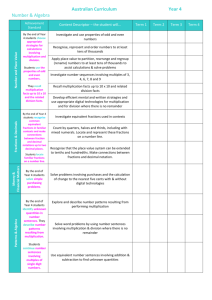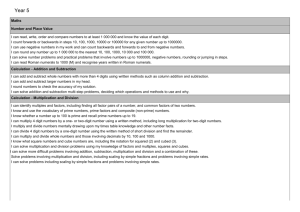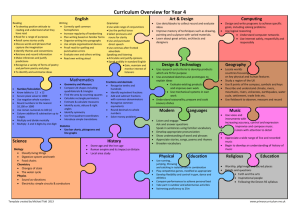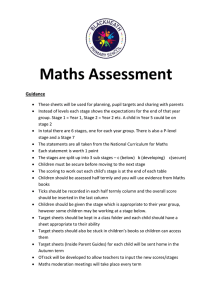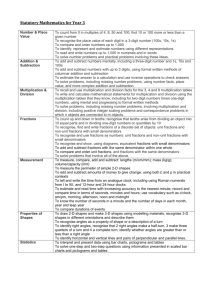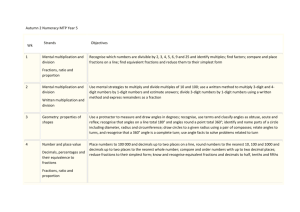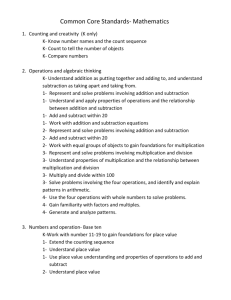Maths Policy - Measham Primary School
advertisement
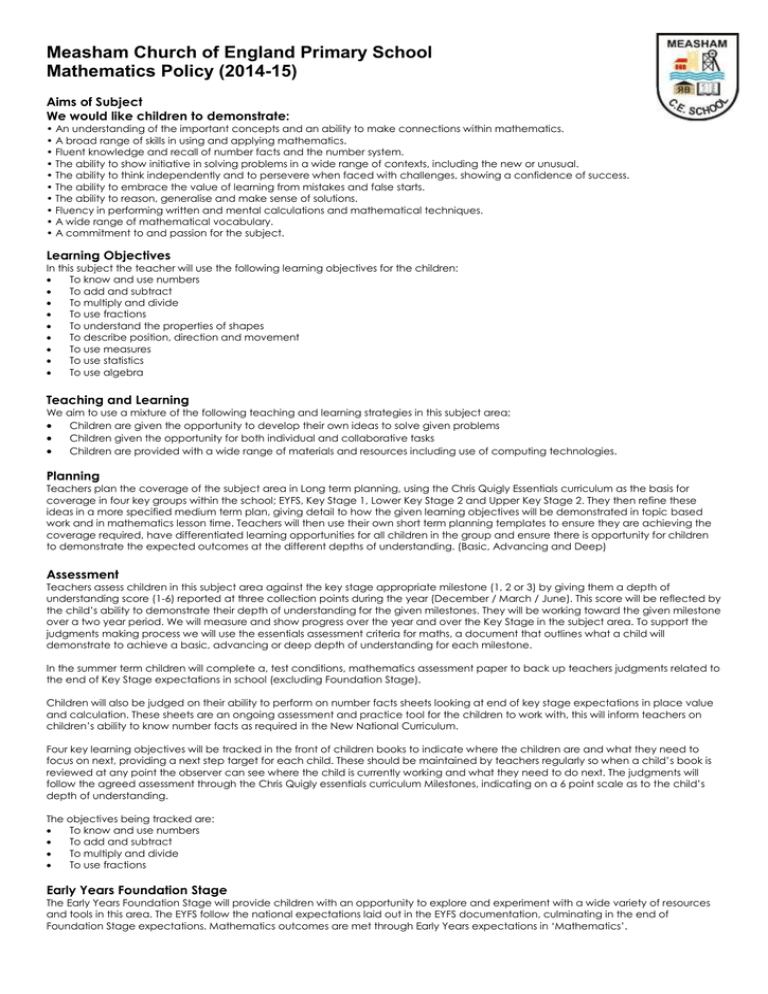
Measham Church of England Primary School Mathematics Policy (2014-15) Aims of Subject We would like children to demonstrate: • An understanding of the important concepts and an ability to make connections within mathematics. • A broad range of skills in using and applying mathematics. • Fluent knowledge and recall of number facts and the number system. • The ability to show initiative in solving problems in a wide range of contexts, including the new or unusual. • The ability to think independently and to persevere when faced with challenges, showing a confidence of success. • The ability to embrace the value of learning from mistakes and false starts. • The ability to reason, generalise and make sense of solutions. • Fluency in performing written and mental calculations and mathematical techniques. • A wide range of mathematical vocabulary. • A commitment to and passion for the subject. Learning Objectives In this subject the teacher will use the following learning objectives for the children: To know and use numbers To add and subtract To multiply and divide To use fractions To understand the properties of shapes To describe position, direction and movement To use measures To use statistics To use algebra Teaching and Learning We aim to use a mixture of the following teaching and learning strategies in this subject area; Children are given the opportunity to develop their own ideas to solve given problems Children given the opportunity for both individual and collaborative tasks Children are provided with a wide range of materials and resources including use of computing technologies. Planning Teachers plan the coverage of the subject area in Long term planning, using the Chris Quigly Essentials curriculum as the basis for coverage in four key groups within the school; EYFS, Key Stage 1, Lower Key Stage 2 and Upper Key Stage 2. They then refine these ideas in a more specified medium term plan, giving detail to how the given learning objectives will be demonstrated in topic based work and in mathematics lesson time. Teachers will then use their own short term planning templates to ensure they are achieving the coverage required, have differentiated learning opportunities for all children in the group and ensure there is opportunity for children to demonstrate the expected outcomes at the different depths of understanding. (Basic, Advancing and Deep) Assessment Teachers assess children in this subject area against the key stage appropriate milestone (1, 2 or 3) by giving them a depth of understanding score (1-6) reported at three collection points during the year (December / March / June). This score will be reflected by the child’s ability to demonstrate their depth of understanding for the given milestones. They will be working toward the given milestone over a two year period. We will measure and show progress over the year and over the Key Stage in the subject area. To support the judgments making process we will use the essentials assessment criteria for maths, a document that outlines what a child will demonstrate to achieve a basic, advancing or deep depth of understanding for each milestone. In the summer term children will complete a, test conditions, mathematics assessment paper to back up teachers judgments related to the end of Key Stage expectations in school (excluding Foundation Stage). Children will also be judged on their ability to perform on number facts sheets looking at end of key stage expectations in place value and calculation. These sheets are an ongoing assessment and practice tool for the children to work with, this will inform teachers on children’s ability to know number facts as required in the New National Curriculum. Four key learning objectives will be tracked in the front of children books to indicate where the children are and what they need to focus on next, providing a next step target for each child. These should be maintained by teachers regularly so when a child’s book is reviewed at any point the observer can see where the child is currently working and what they need to do next. The judgments will follow the agreed assessment through the Chris Quigly essentials curriculum Milestones, indicating on a 6 point scale as to the child’s depth of understanding. The objectives being tracked are: To know and use numbers To add and subtract To multiply and divide To use fractions Early Years Foundation Stage The Early Years Foundation Stage will provide children with an opportunity to explore and experiment with a wide variety of resources and tools in this area. The EYFS follow the national expectations laid out in the EYFS documentation, culminating in the end of Foundation Stage expectations. Mathematics outcomes are met through Early Years expectations in ‘Mathematics’. Cross curricular links Art & Design Computing D&T English Geography History Languages RE PE Music Science Health and Safety Teaching and support staff will supervise all safe use of tools and materials. General teaching requirement for health and safety applies in this subject area. The role of the Subject Leader The Subject Leader will review long term planning to ensure appropriate coverage. They will support teachers in the medium planning process to ensure high quality resourcing, teaching and learning in their subject area. They will review whole school performance in their subject area and provide and end of year review, including areas for development, for submission to the school development plan. They will review children’s work in this area, assist in moderation of judgments across the school and maintain an up to date SL file. Curriculum The new National Curriculum was introduced in 2014, we have adopted Chris Quigly’s interpretation of the National Curriculum, which meets and exceeds the expectations outlined. It is titled the ‘Essentials Curriculum.’ The table below outlines the opportunities that will be provided for the children to learn in Mathematics in Key Stage One and Two. It outlines the learning objectives the children will have to cover in order to become a level appropriate ‘Mathematician.’ These learning objectives remain consistent across the primary age range and progress in each of these is shown over time. The expectation placed on teachers is they not only develop children’s level of understanding to a basic level, but aim to further their understanding to an advancing and deep level of understanding. (See Curriculum Policy for further explanation.) Mathematics Essential Opportunities Key Stage 2 • Count and calculate in a range of practical contexts. • Use and apply mathematics in everyday activities and across the curriculum. • Repeat key concepts in many different practical ways to secure retention. • Explore numbers and place value up to at least 100. • Add and subtract using mental and formal written methods in practical contexts. • Multiply and divide using mental and formal written methods in practical contexts. • Explore the properties of shapes. • Use language to describe position, direction and movement. • Use and apply in practical contexts a range of measures, including time. • Handle data in practical contexts. • Count and calculate in increasingly complex contexts, including those that cannot be experienced first-hand. • Rigorously apply mathematical knowledge across the curriculum, in particular in science, technology and computing. • Deepen conceptual understanding of mathematics by frequent repetition and extension of key concepts in a range of engaging and purposeful contexts. • Explore numbers and place value, so as to read and understand the value of all numbers. • Add and subtract using efficient mental and formal written methods. • Multiply and divide using efficient mental and formal written methods. • Use the properties of shapes and angles in increasingly complex and practical contexts, including in construction and engineering contexts. • Describe position, direction and movement in increasingly precise ways. • Use and apply measures to increasingly complex contexts. • Gather, organise and interrogate data. • Understand the practical value of using algebra. Essential Learning Objectives Milestone 1 End of Year 2 Milestone 2 End of Year 4 Milestone 3 End of Year 6 • Count to and across 100, forwards and backwards, beginning with 0 or 1, or from any given number. • Count, read and write numbers to 100 in numerals; count in multiples of twos, fives and tens. • Given a number, identify one more and one less. • Count in steps of 2, 3, 5 and 10 from 0 or 1 and in tens from any number, forward and backward. • Identify, represent and estimate numbers using different representations, including the number line. • Read and write numbers initially from 1 to 20 and then to at least 100 in numerals and in words. • Use the language of: equal to, more than, less than (fewer), most and least. • Compare and order numbers from 0 up to 100; use <, > and = signs. • Count in multiples of 2 to 9, 25, 50, 100 and 1000. • Find 1000 more or less than a given number. • Count backwards through zero to include negative numbers. • Read numbers up to 10 000 000. • Use negative numbers in context and calculate intervals across zero. • Identify, represent and estimate numbers using different representations. • Read Roman numerals to 100 (I to C) and know that over time, the numeral system changed to include the concept of zero and place value. • Order and compare numbers beyond 1000. • Write numbers up to 10 000 000 • Read Roman numerals to 1000 (M) and recognise years written in Roman numerals. • Recognise the place value of each digit in a two-digit number (tens, ones). • Recognise the place value of each digit in a four-digit number. (thousands, hundreds, tens, and ones) • Round any number to the nearest 10, 100 or 1000. • Solve number and practical problems with increasingly large positive numbers. • Round any whole number to a required degree of accuracy. • Determine the value of each digit in any number. Representing Comparing Place Value • Use place value and number facts to solve problems. Solving problems To know and use numbers Counting Essential Opportunities Key Stage 1 • Order and compare numbers up to 10 000 000. • Solve number and practical problems. Complexity Method Checking Using number facts To add and subtract • Solve one-step problems with addition and subtraction: • Using concrete objects and pictorial representations including those involving numbers, quantities and measures. • Using the addition (+), subtraction (-) and equals (=) signs. • Applying their increasing knowledge of mental and written methods. • Add and subtract numbers using concrete objects, pictorial representations, and mentally, including: • One-digit and two-digit numbers to 20, including zero. • A two-digit number and ones. • A two-digit number and tens. • Two two-digit numbers. • Adding three one-digit numbers. • Show that addition of two numbers can be done in any order (commutative) and subtraction of one number from another cannot. • Recognise and use the inverse relationship between addition and subtraction and use this to check calculations and solve missing number problems. • Solve two-step addition and subtraction problems in contexts, deciding which operations and methods to use and why. • Solve multi-step addition and subtraction problems in contexts, deciding which operations and methods to use and why. • Add and subtract numbers with up to 4 digits using the formal written methods of columnar addition and subtraction where appropriate. • Add and subtract numbers mentally, including: • A three-digit number and ones. • A three-digit number and tens. • A three-digit number and hundreds. • Add and subtract whole numbers with more than 4 digits, including using formal written methods. (columnar addition and subtraction) • Add and subtract numbers mentally with increasingly large numbers. • Estimate and use inverse operations to check answers to a calculation. • Use rounding to check answers to calculations and determine, in the context of a problem, levels of accuracy. • Represent and use number bonds and related subtraction facts within 20. • Recall and use addition and subtraction facts to 20 fluently, and derive and use related facts up to 100. • Solve problems, including missing number problems, using number facts, place value and more complex addition and subtraction. • Add and subtract negative integers. Complexity Methods Checking Using multiplication and division facts To multiply and divide • Solve one-step problems involving multiplication and division by calculating the answer using concrete objects, pictorial representations and arrays with the support of the teacher. • Solve problems involving multiplying and adding, including using the distributive law to multiply two digit numbers by one digit, integer scaling problems and harder correspondence problems (such as n objects are connected to m objects). • Solve problems involving addition, subtraction, multiplication and division and a combination of these, including understanding the meaning of the equals sign. • Solve problems involving multiplication and division, including scaling by simple fractions and problems involving simple rates. • Use knowledge of the order of operations to carry out calculations involving the four operations. • Multiply multi-digit numbers up to 4 digits by a two-digit whole number using the formal written method of long multiplication. • Divide numbers up to 4 digits by a twodigit whole number using the formal written method of long division, and interpret remainders as whole number remainders, fractions, or by rounding, as appropriate for the context. • Divide numbers up to 4 digits by a twodigit number using the formal written method of short division where appropriate, interpreting remainders according to the context. • Perform mental calculations, including with mixed operations and large numbers. • Calculate mathematical statements for multiplication and division within the multiplication tables and write them using the multiplication (.), division (÷) and equals (=) signs. • Show that multiplication of two numbers can be done in any order (commutative) and division of one number by another cannot. • Solve problems involving multiplication and division using mental methods. • Multiply two-digit and three-digit numbers by a one-digit number using formal written layout. • Use place value, known and derived facts to multiply and divide mentally, including: multiplying by 0 and 1; dividing by 1; multiplying together three numbers. • Recognise and use factor pairs and commutativity in mental calculations. • Use known multiplication facts to check the accuracy of calculations. • Recognise and use the inverse relationship between multiplication and division and use this to check calculations and solve missing number problems. • Estimate and use inverse operations and rounding to check answers to a calculation. • Recall and use multiplication and division facts for the 2, 5 and 10 multiplication tables. • Recognise odd and even numbers. • Use multiplication and division facts to solve problems. • Recall multiplication and division facts for multiplication tables up to 12 × 12. • Identify common factors, common multiples and prime numbers. • Establish whether a number up to 100 is prime and recall prime numbers up to 19. • Multiply and divide whole numbers and those involving decimals by 10, 100 and 1000. • Recognise and use square numbers and cube numbers, and the notation for squared (2) and cubed (3). • Solve problems involving multiplication and division including using knowledge of factors and multiples, squares and cubes. Recognising fractions • Recognise, find and write fractions of a discrete set of objects: unit fractions and non-unit fractions with small denominators. • Recognise and use fractions as numbers: unit fractions and non-unit fractions with small denominators. • Round decimals with one decimal place to the nearest whole number. • Compare numbers with the same number of decimal places up to two decimal places. • Count up and down in tenths; recognise that tenths arise from dividing an object into 10 equal parts and in dividing one-digit numbers or quantities by 10. • Count up and down in hundredths; recognise that hundredths arise when dividing an object by one hundred and dividing tenths by ten. • Compare and order unit fractions and fractions with the same denominators. • Recognise the equivalence of 2/4 and 1/2. • Recognise and show, using diagrams, families of common equivalent fractions. • Recognise and write decimal equivalents of any number of tenths or hundredths. • Recognise and write decimal equivalents to 1/4, 1/2, 3/4. • Write simple fractions for example, 1/2 of 6 = 3. • Add and subtract fractions with the same denominator within one whole. • Solve problems involving increasingly harder fractions. • Calculate quantities and fractions to divide quantities (including nonunit fractions where the answer is a whole number). • Add and subtract fractions with the same denominator. • Find the effect of dividing a one- or twodigit number by 10 and 100, identifying the value of the digits in the answer as ones, tenths and hundredths. • Solve simple measure and money problems involving fractions and decimals to two decimal places. Equivalence Solving problems Fractions (including decimals, percentages, ratio and proportion) • Recognise, find and name a half as one of two equal parts of an object, shape or quantity. • Recognise, find and name a quarter as one of four equal parts of an object, shape or quantity. • Recognise, find, name and write fractions 1/2, 1/4, 2/4 and 3/4 of a length, shape, set of objects or quantity. • Compare and order fractions whose denominators are all multiples of the same number. • Compare and order fractions, including fractions > 1. • Recognise mixed numbers and improper fractions and convert from one form to the other and write mathematical statements > 1 as a mixed number. • Round decimals with two decimal places to the nearest whole number and to one decimal place. • Read, write, order and compare numbers with up to three decimal places. • Identify the value of each digit in numbers given to three decimal places. • Solve problems involving number up to three decimal places. • Recognise the per cent symbol (%) and understand that per cent relates to ‘number of parts per hundred’, and write percentages as a fraction with denominator 100, and as a decimal. • Identify, name and write equivalent fractions of a given fraction, represented visually, including tenths and hundredths. • Read and write decimal numbers as fractions. • Recognise and use thousandths and relate them to tenths, hundredths and decimal equivalents. • Use common factors to simplify fractions; use common multiples to express fractions in the same denomination. • Associate a fraction with division and calculate decimal fraction equivalents. • Recall and use equivalences between simple fractions, decimals and percentages, including in different contexts. • Add and subtract fractions with the same denominator and denominators that are multiples of the same number. • Add and subtract fractions with different denominators and mixed numbers, using the concept of equivalent fractions. • Multiply proper fractions and mixed numbers by whole numbers, supported by materials and diagrams. • Multiply simple pairs of proper fractions, writing the answer in its simplest form. • Solve problems which require knowing percentage and decimal equivalents of, 1/2, 1/4, 1/5, 2/5, 4/5 and those fractions with a denominator of a multiple of 10 or 25. • Divide proper fractions by whole numbers. • Multiply and divide numbers by 10, 100 and 1000 giving answers up to three decimal places. Ratio and proportion • Solve problems involving the relative sizes of two quantities where missing values can be found by using integer multiplication and division facts. • Solve problems involving the calculation of percentages and the use of percentages for comparison. • Solve problems involving similar shapes where the scale factor is known or can be found. • Solve problems involving unequal sharing and grouping using knowledge of fractions and multiples. To understand the properties of shapes To describe position, direction and movement • Recognise and name common 2D and 3D shapes. • Identify and describe the properties of 2D shapes, including the number of sides and line symmetry in a vertical line. • Identify and describe the properties of 3D shapes, including the number of edges, vertices and faces. • Identify 2-D shapes on the surface of 3-D shapes. • Compare and sort common 2-D and 3-D shapes and everyday objects. • Draw 2-D shapes and make 3-D shapes using modelling materials; recognise 3-D shapes in different orientations and describe them. • Recognise angles as a property of shape or a description of a turn. • Identify right angles, recognise that two right angles make a half-turn, three make three quarters of a turn and four a complete turn; identify whether angles are greater than or less than a right angle. • Identify horizontal and vertical lines and pairs of perpendicular and parallel lines. • Compare and classify geometric shapes, including quadrilaterals and triangles, based on their properties and sizes. • Identify acute and obtuse angles and compare and order angles up to two right angles by size. • Identify lines of symmetry in 2-D shapes presented in different orientations. • Complete a simple symmetric figure with respect to a specific line of symmetry. • Describe position, direction and movement, including whole, half, quarter and three-quarter turns. • Order and arrange combinations of mathematical objects in patterns and sequences. • Use mathematical vocabulary to describe position, direction and movement, including movement in a straight line and distinguishing between rotation as a turn and in terms of right angles for quarter, half and three-quarter turns (clockwise and anti-clockwise). • Recognise angles as a property of shape and as an amount of rotation. • Identify right angles, recognise that 2 right angles make a half turn and 4 make a whole turn. • Identify angles that are greater than a right angle. • Describe positions on a 2-D grid as coordinates in the first quadrant. • Describe movements between positions as translations of a given unit to the left/right and up/down. • Plot specified points and draw sides to complete a given polygon. • Solve addition and subtraction, multiplication and division problems that involve missing numbers. To use algebra • Solve addition and subtraction problems involving missing numbers. • Identify 3-D shapes, including cubes and other cuboids, from 2-D representations. • Know angles are measured in degrees: estimate and compare acute, obtuse and reflex angles. • Draw given angles, and measure them in degrees (°). • Identify: • Angles at a point and one whole turn (total 360°). • Angles at a point on a straight line and a turn (total 180°). • Other multiples of 90°. • Use the properties of rectangles to deduce related facts and find missing lengths and angles. • Distinguish between regular and irregular polygons based on reasoning about equal sides and angles. • Draw 2-D shapes using given dimensions and angles. • Recognise, describe and build simple 3-D shapes, including making nets. • Compare and classify geometric shapes based on their properties and sizes and find unknown angles in any triangles, quadrilaterals, and regular polygons. • Illustrate and name parts of circles, including radius, diameter and circumference and know that the diameter is twice the radius. • Recognise angles where they meet at a point, are on a straight line, or are vertically opposite and find missing angles. • Identify, describe and represent the position of a shape following a reflection or translation, using the appropriate language, and know that the shape has not changed. • Describe positions on the full coordinate grid. (all four quadrants) • Draw and translate simple shapes on the coordinate plane, and reflect them in the axes. • Use simple formulae. • Generate and describe linear number sequences. • Express missing number problems algebraically. • Find pairs of numbers that satisfy an equation with two unknowns. • Enumerate possibilities of combinations of two variables. To use measures To use statistics • Compare, describe and solve practical problems for: •lengths and heights. •mass/weight. •capacity and volume. •time. • Measure and begin to record: •lengths and heights. •mass/weight. •capacity and volume. •time. (hours, minutes, seconds). • Recognise and know the value of different denominations of coins and notes. • Sequence events in chronological order using language. • Recognise and use language relating to dates, including days of the week, weeks, months and years. • Tell the time to the hour and half past the hour and draw the hands on a clock face to show these times. • Choose and use appropriate standard units to estimate and measure length/height (m/cm); mass (kg/g); temperature (°C); capacity (litres/ml) to the nearest appropriate unit, using rulers, scales, thermometers and measuring vessels. • Compare and order lengths, mass, volume/capacity and record the results using >, < and =. • Recognise and use symbols for pounds (£) and pence (p); combine amounts to make a particular value. • Find different combinations of coins that equal the same amounts of money. • Solve simple problems in a practical context involving addition and subtraction of money of the same unit, including giving change. • Compare and sequence intervals of time. • Tell and write the time to five minutes, including quarter past/to the hour and draw the hands on a clock face to show these times. • Know the number of minutes in an hour and the number of hours in a day. • Interpret and construct simple pictograms, tally charts, block diagrams and simple tables. • Ask and answer simple questions by counting the number of objects in each category and sorting the categories by quantity. • Ask and answer questions about totalling and comparing categorical data. • Measure, compare, add and subtract: lengths (m/cm/mm); mass (kg/g); volume/capacity (l/ml). • Measure the perimeter of simple 2-D shapes. • Add and subtract amounts of money to give change. (£ and p) • Tell and write the time from an analogue clock, including using Roman numerals from I to XII, and 12-hour and 24-hour clocks. • Estimate and read time with increasing accuracy to the nearest minute; record and compare time in terms of seconds, minutes and hours; use appropriate vocabulary. • Know the number of seconds in a minute and the number of days in each month, year and leap year. • Compare durations of events. • Convert between different units of measure. (for example, kilometre to metre; hour to minute) • Measure and calculate the perimeter of a rectilinear figure (including squares) in centimetres and metres. • Find the area of rectilinear shapes by counting squares. • Estimate, compare and calculate different measures, including money in pounds and pence. • Read, write and convert time between analogue and digital 12- and 24-hour clocks. • Solve problems involving converting from hours to minutes; minutes to seconds; years to months; weeks to days. • Convert between different units of metric measure. • Understand and use approximate equivalences between metric units and common imperial units such as inches, pounds and pints. • Measure and calculate the perimeter of composite rectilinear shapes in centimetres and metres. • Calculate and compare the area of rectangles (including squares), and including using standard units, square centimetres (cm2) and square metres (m2) and estimate the area of irregular shapes. • Estimate volume and capacity. • Solve problems involving converting between units of time. • Use all four operations to solve problems involving measure (for example, length, mass, volume, money) using decimal notation, including scaling. • Solve problems involving the calculation and conversion of units of measure, using decimal notation up to three decimal places where appropriate. • Use, read, write and convert between standard units, converting measurements of length, mass, volume and time from a smaller unit of measure to a larger unit, and vice versa, using decimal notation to up to three decimal places. • Convert between miles and kilometres. • Recognise that shapes with the same areas can have different perimeters and vice versa. • Recognise when it is possible to use formulae for area and volume of shapes. • Calculate the area of parallelograms and triangles. • Calculate, estimate and compare volume of cubes and cuboids using standard units, including cubic centimetres (cm3) and cubic metres (m3), and extending to other units. • Interpret and present data using bar charts, pictograms and tables. • Solve one-step and two-step questions (for example, ‘How many more?’ and ‘How many fewer?’) using information presented in scaled bar charts, pictograms and tables. • Interpret and present discrete and continuous data using appropriate graphical methods, including bar charts and time graphs. • Solve comparison, sum and difference problems using information presented in bar charts, pictograms, tables and other graphs. • Solve comparison, sum and difference problems using information presented in a line graph. • Complete, read and interpret information in tables, including timetables. • Interpret and construct pie charts and line graphs and use these to solve problems. • Calculate and interpret the mean as an average.

